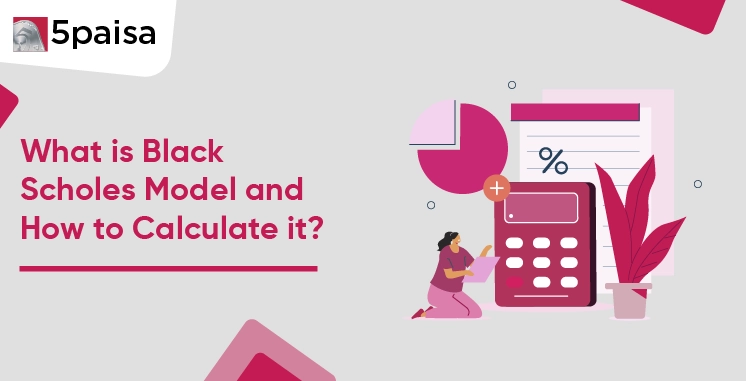Content
The Black-Scholes model is one of the most widely used tools in the world of finance for pricing options. Developed in the early 1970s, it gave traders a systematic way to determine what an option should be worth based on a few measurable factors.
Whether you're new to trading or looking to deepen your understanding of derivatives, learning about the Black-Scholes option pricing model is a great place to start. This model isn’t just academic—it’s still widely used by analysts, fund managers, and individual traders around the world.
Unlock the full article - sign in with Gmail!
Expand Your Market Knowledge with 5paisa Articles
History and Origin of the Black-Scholes Model
The Black-Scholes model was introduced in 1973 by economists Fischer Black and Myron Scholes. Their work was later refined by Robert Merton, who helped expand the model’s mathematical foundation. This breakthrough led to a Nobel Prize in Economic Sciences for Scholes and Merton in 1997 (Black had passed away earlier and was not eligible for the award).
Before this model, there was no standard way to price options. Traders relied on intuition or rudimentary methods. The Black-Scholes equation changed that by providing a structured and mathematical approach to option valuation.
How Black Scholes Model Works
The Black-Scholes option valuation model is designed to estimate the fair price of a European-style option—a type of option that can only be exercised on its expiration date.
The model calculates an option's price by considering several important factors:
- Current price of the underlying asset (S)
- Strike price of the option (K)
- Time remaining until expiration (T), expressed in years
- Risk-free interest rate (r), such as the return on government bonds
- Volatility (σ) of the underlying asset, which measures how much the price is expected to fluctuate
The idea is simple: if you know these variables, you can plug them into the Black-Scholes formula and get a theoretical option price. Traders can then compare this theoretical price with the market price to decide whether an option is overvalued or undervalued.
The Black-Scholes Model Formula
The Black-Scholes model equation for pricing a European call option is:
C=S0N(d1)−Ke−rTN(d2)
Where:
- C = Price of the call option
- S0 = Current price of the stock
- K = Strike price
- T= Time to expiration (in years)
- r = Risk-free interest rate
- N() = Cumulative standard normal distribution
- d1=σTln(S0/K)+(r+21σ2)T
- d2=d1−σTd
This formula, often called the BSM formula (short for Black-Scholes-Merton formula), gives a theoretical price based on the input assumptions. It is the foundation of the Black-Scholes option pricing model, and variations of it are used to price other types of options and derivatives.
Benefits of the Black-Scholes Model
The Black-Scholes model offers several advantages, especially for traders and financial institutions looking for a standardised method of pricing options:
- Clarity and Consistency: The model provides a transparent and consistent framework for calculating option prices.
- Speed and Efficiency: The BSM model uses a closed-form equation, which allows for fast and easy calculations.
- Helps Identify Mispricing: By comparing the theoretical value from the Black-Scholes formula to market prices, traders can spot undervalued or overvalued options.
- Widely Accepted: The model has become a universal standard, making it easier to communicate and compare pricing strategies across markets.
Limitations of the Black-Scholes Model
Despite its popularity, the Black-Scholes option pricing model is not without flaws. It relies on a number of assumptions that don’t always hold true in the real world:
- Assumes Constant Volatility: In reality, volatility can change rapidly, especially during major news events or market stress.
- Only for European Options: The basic model doesn’t work for American options, which can be exercised before the expiration date.
- No Transaction Costs or Taxes: The model assumes a “perfect” market where trading is free and frictionless.
- No Dividends Considered: Unless specifically modified, the model doesn’t account for dividend payments.
- Normal Distribution Assumption: It assumes that asset prices follow a log-normal distribution, which may not reflect actual price behavior.
For these reasons, traders often adjust the Black-Scholes model equation or use alternative models when market conditions don’t align with its assumptions.
Real-world Examples of Black-Scholes Model
Let’s look at a simple example of how the Black-Scholes formula is used in real life.
Suppose a stock is trading at ₹1,000 and you’re considering buying a call option with:
- A strike price of ₹1,050
- 30 days until expiration
- A risk-free interest rate of 6% per annum
- An annual volatility of 25%
By entering these values into the BSM formula, you can calculate the theoretical value of the call option. If the market is charging significantly more or less than this value, it might indicate an opportunity to buy or sell.
In practice, traders use software or online calculators to apply the Black-Scholes model, especially when working with a large number of contracts.
Black-Scholes vs Other Pricing Models
While the Black-Scholes option valuation model is popular, other models are also used depending on the type of option and market conditions.
Common Alternatives:
- Binomial Tree Model: This model breaks down time into small intervals and evaluates option prices at each node. It’s especially useful for American options.
- Monte Carlo Simulation: Often used for complex or path-dependent options, this method runs thousands of random price scenarios.
- Finite Difference Methods: These are numerical techniques used to solve more complex derivatives pricing equations.
How They Compare:
| Model |
Strengths |
Weaknesses |
| Black-Scholes |
Fast, simple, and widely used |
Assumes constant volatility and no dividends |
| Binomial Tree |
Great for American options |
Slower and more complex |
| Monte Carlo Simulation |
Good for exotic options and simulations |
Time-consuming and less intuitive |
While these models may offer more flexibility, the Black-Scholes model remains the go-to tool for quick, consistent pricing of plain vanilla European options.
The Bottom Line
The Black-Scholes model is a powerful and time-tested tool for pricing European call options. It takes into account the most critical factors—price, time, interest rates, and volatility—to provide a fair value estimate.
However, no model is perfect. The Black-Scholes formula works best under specific assumptions, and traders must be aware of its limitations. Still, the Black-Scholes option pricing model is essential for anyone serious about understanding how the options market operates.
By mastering this model, traders can make more informed decisions, identify better entry and exit points, and evaluate risk with greater precision.



